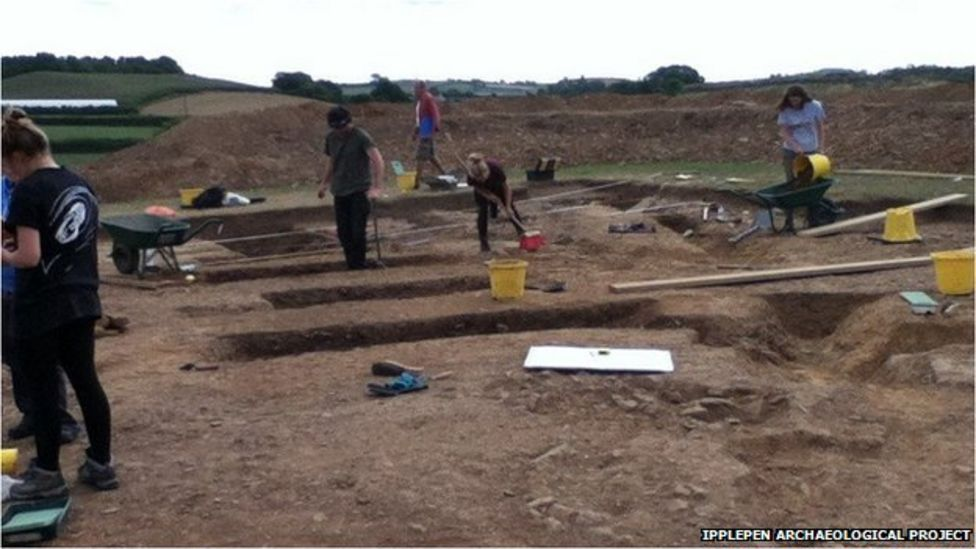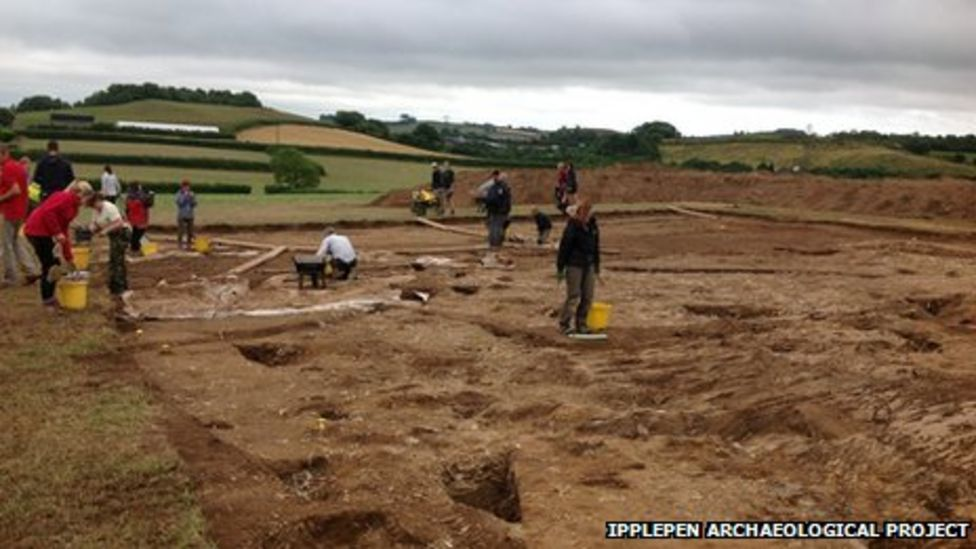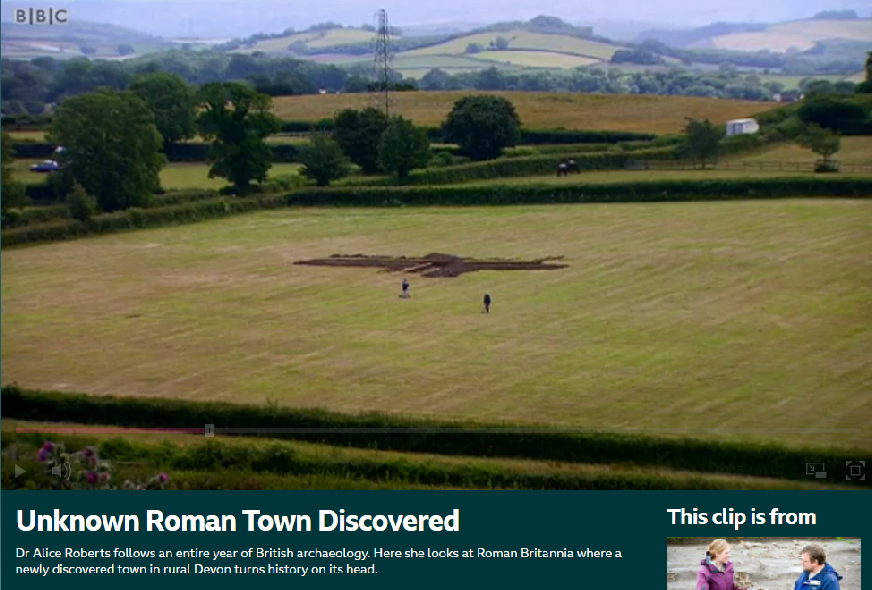
Uncovering Ipplepen's past
2009: Roman coins are first discovered at Ipplepen, near Newton Abbot
2011: Trial excavations begin
2012: A Roman road, a square enclosure ditch of Roman date, and an Iron Age/Romano-British round house are discovered
February 2015: A Roman cemetery is been discovered, revealing 15 skeletons
June 2016: The boundaries of the Roman Empire are redrawn after it is discovered the settlement had trade links to the rest of the Empire

About 40 villagers from Ipplepen have been helping at the excavation
An Iron Age settlement unearthed in Devon has been described as one of the most important finds of its kind.
It was prompted by the chance discovery of Roman coins in fields at Ipplepen, near Newton Abbot about four years ago.
Archaeologists, who have recently started examining the site, said it is the first of its kind in the county.
The excavation is being funded by the British Museum, Exeter University, the Portable Antiquities Scheme (PAS) and Devon County Council.
Sam Moorhead from the British Museum said he believed the Ipplepen site was "one of the most significant Roman discoveries in the country for many decades".
The site was discovered by local metal detector enthusiasts Jim Wills and Dennis Hewings, who contacted archaeologist Danielle Wootton, the Devon finds liaison officer for the PAS.
'Electric atmosphere'
Ms Wootton said local people had been involved in the project, with about 40 volunteers helping at the excavation site.
"When we announced the find at a community meeting about three years ago, the hall was absolutely packed with local people and there was an electric atmosphere," she told BBC News.
"The bit we've excavated at the moment is prehistoric - it's Iron Age - but we have picked up traces of some Roman Romano-British field boundaries," she said.
Ipplepen excavation
Image caption,
The British Museum said the Ipplepen site was one of the most significant Roman discoveries in England for decades
"It's probably going to take us a very long time for us to fully understand the nature of the settlement and how long it was occupied for.
Ms Wootton said the important discovery should be credited to Mr Wills and Mr Hewings who had painstakingly recorded "every scrap of metal" they found.
"Jim and Dennis have been absolutely first class in recording what they've found and it's a result of them being responsible with their metal detecting that we've discovered this site," she said.
Mr Wills said the oldest coin he found dated back to 117BC,
"The very first Roman coin I found strangely enough - and this is out of more than 100 coins we found subsequently - is still the oldest of all the coins," he said.
"I've been detecting for many years, but it's always thrilling to dig up something you recognise is really important."
Part of the settlement excavation site will be open to the public on Sunday.
Related Internet Links
Portable Antiquities Scheme
British Museum
University of Exeter
The BBC is not responsible for the content of external sites.

Archaeologist at the Ipplepen siteIMAGE SOURCE,UNIVERSITY OF EXETER
Image caption,
Archaeologists said the discoveries were both regionally and nationally important
A "major" Roman cemetery has been discovered during an archaeological dig in Devon.
Experts found 15 skeletons during the excavation of a Roman road at Ipplepen, near Exeter.
Tests on one of the skeletons showed the settlement was in use up to 350 years after the Roman period ended, which has surprised experts.
Archaeologists said the discoveries were both nationally and regionally important.
Danielle Wootton, from the Portable Antiquities Scheme, said: "As the excavation progressed, it became clear that we were dealing with one of the most significant Romano-British cemeteries discovered in Devon and that it had huge potential to develop our understanding of settlements and how people lived in the South West 2,000 years ago."
The Romans invaded Britain in 43 AD and their reign ended in about 410 AD.
Ms Wootton said the discovery of a body from up to 350 years after they left "suggests continuation of the settlement after the Roman period and shows that life carried on at Ipplepen rather than falling out of use."
The team, from the University of Exeter, hopes further research will more about the ages of those who died, along with the diets and diseases they had.
Bill Horner, county archaeologist, said: "This is one of the most important discoveries in Devon in recent years.
"The concentration and range of finds and archaeological features is really exciting."
The Ipplepen project is supported by the University of Exeter, the Portable Antiquities Scheme, the British Museum and Devon County Council.

COIN
Unique ID: DEV-FB6B2A
Object type certainty: Certain
Workflow status: Awaiting validation Find awaiting validation
A highly abraded Roman copper alloy Sestertius or Dupondius, probably of an empress but detail unclear. Probably dating to c. AD 100-200. Uncertain reverse type, depicting a central figure standing left with right arm raised.
Subsequent actions
Subsequent action after recording: Returned to finder
Chronology
Broad period: ROMAN
Period from: ROMAN
Period to: ROMAN
Date from: Circa AD 1
Date to: Circa AD 200
Dimensions and weight
Quantity: 1
Weight: 10.38 g
Diameter: 28.5 mm
Personal details
This information is restricted for your access level.
Other reference numbers
Other reference: SCC receipt: 019397
Materials and construction
Primary material: Copper alloy
Manufacture method: Struck or hammered
Completeness: Complete
Coin data (numismatics)
Denomination: Sestertius, dupondius or as
Denomination qualifier: Certain
Obverse description: Bust right, probably female
Obverse inscription: Illegible
Reverse description: Probable male figure standing left with right arm raised
Reverse inscription: Illegible
Die axis measurement: 6 o'clock
Degree of wear: Extremely worn: poor
Status: Regular
Coin references
No coin references available.
Spatial metadata
Region: South West (European Region)
County or Unitary authority: Devon (County)
District: Teignbridge (District)
To be known as: Ipplepen CP
Spatial coordinates
Grid reference source: GPS (from the finder)
Unmasked grid reference accurate to a 1 metre square.
Discovery metadata
Method of discovery: Metal detector
General landuse: Grassland, Heathland
References cited
No references cited so far.
Similar objects
Find number: SOM-152AE6
Object type: COIN
Broadperiod: ROMAN
A Roman copper alloy probable Dupondius of an uncertain probable second centruy ruler, c. AD 100-200. Uncertain reverse type, depicting a fem…
Workflow: Awaiting validationFind awaiting validation
Find number: SOM-C5ADD6
Object type: COIN
Broadperiod: ROMAN
A corroded Roman copper-alloy dupondius or as of uncertain 2nd-century ruler dating to the period c. AD 100-200 (uncertain Reece period). Unc…
Workflow: Awaiting validationFind awaiting validation
Find number: SOM-C420F1
Object type: COIN
Broadperiod: ROMAN
A Roman copper alloy sestertius of uncertain second century ruler c.AD100-200. Uncertain reverse type depicting female figure standing left. …
Workflow: Awaiting validationFind awaiting validation
Timeline of associated dates
Associated dates for DEV-FB6B2A
Dates mentioned in this record
Record ID: DEV-5BA7A3
Object type: TOBACCO HOLDERRecord ID: DEV-5BA7A3
Object type: TOBACCO HOLDER
Broad period: POST MEDIEVAL
County: Devon
Workflow stage: Awaiting validation Find awaiting validation
A post medieval lead alloy tobacco jar lid handle dating to the period c. AD 1700-1800. The handle comprises a central conical boss surrounded by a circular collar and eight oval petals, one of whch has been bent out of shape. Below is a waisted short shank which expands again as a smaller circular collared plate with a protruding lug. The lower plate has been squashed out of shape. The lower parts would engage a lid of different material. Similar examples include: NLM-5268E6. The handle measures 24.86mm in diameter, 21.74mm in height and weighs 25.22g.
Created on: Thursday 18th August 2016
Last updated: Tuesday 6th September 2016
Spatial data recorded. This findspot is known as 'Ipplepen', grid reference and parish protected
Broad period: POST MEDIEVAL
County: Devon
Workflow stage: Awaiting validation Find awaiting validation
A post medieval lead alloy tobacco jar lid handle dating to the period c. AD 1700-1800. The handle comprises a central conical boss surrounded by a circular collar and eight oval petals, one of whch has been bent out of shape. Below is a waisted short shank which expands again as a smaller circular collared plate with a protruding lug. The lower plate has been squashed out of shape. The lower parts would engage a lid of different material. Similar examples include: NLM-5268E6. The handle measures 24.86mm in diameter, 21.74mm in height and weighs 25.22g.
Created on: Thursday 18th August 2016
Last updated: Tuesday 6th September 2016
Spatial data recorded. This findspot is known as 'Ipplepen', grid reference and parish protected
Record ID: FASAM-BDA6E2
Object type: COIN
Broad period: ROMAN
County: Devon
Workflow stage: Published Find published
Copper-alloy as, probably of Vespasian (AD 69-79) (Reece Period 4), probably FIDES PVBLICA. Mint unclear. See RIC II (2nd ed), plate 62, no. 1164 for possible type. (Checked by SM)
Created on: Monday 14th October 2013
Last updated: Monday 14th October 2013
Spatial data recorded. This findspot is known as 'Ipplepen', grid reference and parish protected.
Thumbnail image of FASAM-BC8684
Record ID: FASAM-BC8684
Object type: COIN
Broad period: ROMAN
County: Devon
Workflow stage: Published Find published
Silver denarius of Tiberius (AD 14-37) (Reece Period 1), PONTIF MAXIM, female seated right. Mint of Lyon (Lugdunum). RIC I, p. 95, no. 30. (Checked by SM)
Created on: Monday 14th October 2013
Last updated: Monday 14th October 2013
Spatial data recorded. This findspot is known as 'Ipplepen', grid reference and parish protected.
Thumbnail image of FASAM-BC6601
Record ID: FASAM-BC6601
Object type: COIN
Broad period: ROMAN
County: Devon
Workflow stage: Published Find published
A denarius of Augustus dating to 15-13 BC (Reece Period 1); IMP X ACT reverse type depicting Apollo Citharoedus standing left in long drapery, holding plectrum in right hand and a lyre in left hand. Mint of Lugdunum. RIC I (rev.ed.) p. 52, no. 171a.
Created on: Monday 14th October 2013
Last updated: Thursday 2nd January 2014
Spatial data recorded. This findspot is known as 'Ipplepen', grid reference and parish protected.
Thumbnail image of DEV-7E4FB5
Record ID: DEV-7E4FB5
Object type: COIN
Broad period: ROMAN
County: Devon
Workflow stage: Published Find published
Roman copper alloy as or dupondius, probably of the emperor Vespasian (AD 69 - 79) (Reece Period 4), reverse unclear, but probably a standing figure. Mint unclear. (Checked by SM)
Created on: Friday 27th August 2010
Last updated: Monday 14th October 2013
Spatial data recorded. This findspot is known as 'Ipplepen', grid reference and parish protected.







